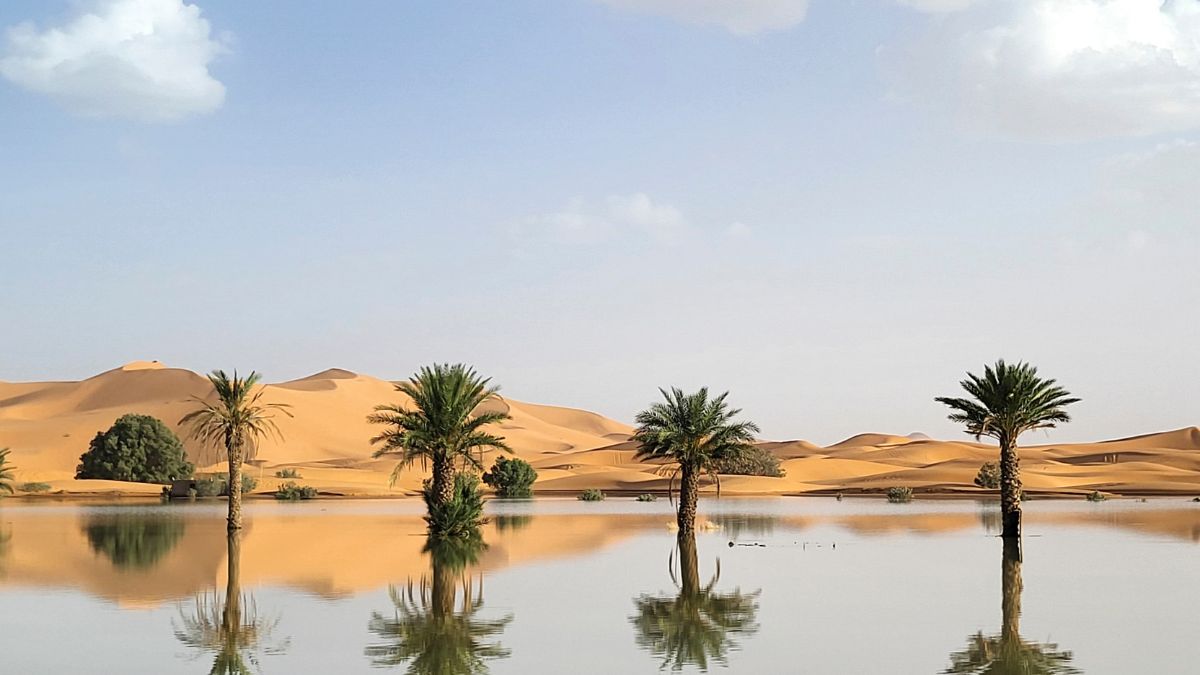A rare deluge left parts of the Sahara desert flooded, with dramatic visuals showing palm trees and sand dunes inundated. These were the first floods in the Sahara in half a century.
Heavy downpours that triggered floods in southeastern Morocco last month killed 18 people. According to the Moroccan government, two days of rainfall in September surpassed yearly averages in many areas, including Tata city. Tagounite, a village about 450 kilometres south of the capital, Rabat, witnessed 100 millimetres of rain in 24 hours, as per an Associated Press (AP) report.
The long-awaited rains came when Morocco was reeling from the worst drought in nearly 40 years. The North African country, which is among the world’s most water-stressed nations, experiences frequent droughts.
Images from United States’ National Aeronautics and Space Administration (Nasa) satellites showed Lake Iriqui, a famous lake bed between Zagora and Tata, filled with water after being dry for 50 years.
Houssine Youabeb of Morocco’s General Directorate of Meteorology told AP, “It’s been 30 to 50 years since we’ve had this much rain in such a short space of time.”
Meteorologists have described these rains as an extratropical storm which could change the weather of the region in the coming months and years. As the air holds more moisture, it causes evaporation and brings on more storms, Youabeb added.
Spread across 9.4 million square kilometres, the Sahara is the largest hot desert in the world. It spans dozens of countries in north, central and west Africa.
According to experts, climate change is making extreme weather, such as storms and droughts, more frequent and intense. Scientists warn the Sahara can report similar storms in the future.
Moroccans should be ready “for new phenomena whose frequency and violence are unknown, given the effects of climate change”, Mohamed Said Karrouk, a climatology professor at Hassan II University in Casablanca, was quoted as saying by AFP.
Celeste Saulo, the secretary general of the World Meteorological Organization, told reporters on Monday (October 7) that water cycles were changing with surging frequency worldwide.
“As a result of rising temperatures, the hydrological cycle has accelerated. It has also become more erratic and unpredictable, and we are facing growing problems of either too much or too little water,” she said.
The torrential rains in Morocco’s arid south brought relief to farmers growing crops like almonds, dates and cereals. Six straight years of droughts have posed significant challenges for the farmers.
Mohamed Jalil, a water resources consultant, told AFP last month that the deluge would help replenish soil saturation levels, but added that this requires rainfall over time after a long drought.
“This will bring respite to the oases, particularly for agriculture,” he said. Jalil added that the bounty of rainfall “brought hope” to the drought-hit area.
The heavy rainfall is expected to help refill the large groundwater aquifers that are used to supply water in desert communities. The storm led to the region’s reservoirs refilling at record rates last month, reported AP.
But it is yet to be known how much the rains will alleviate drought.


)

)
)
)
)
)
)
)
)



